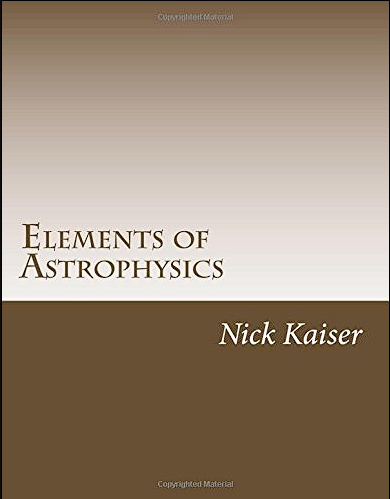
Elements of Astrophysics
Author: Nick Kaiser Category: Astrofisika Publisher: CreateSpace Independent Publishing Platform ISBN: 9781503100114 These are the notes that have grown out of a introductory graduate course I have given for the
past few years at the IfA. They are meant to be a ‘primer’ for students embarking on a Ph.D. in
astronomy. The level is somewhat shallower than standard textbook courses, but quite a broad
range of material is covered. The goal is to get the student to the point of being able to make
meaningful order-of-magnitude calculations — and a number of problems are included — and to
give the students a fairly uniform base in the relevant physics that they can use as a starting point
and introduction to the more detailed textbooks they will need to use when they come to address
serious problems. The books that I have drawn upon extensively in devising this course are Rybicki
and Lightman; Shu’s two-volume series; Longair’s two-volume series; various sections of Landau and
Lifshitz (Classical theory of fields; Mechanics and Fluid Mechanics in particular); Huang’s statistical
mechanics, and Binney and Tremaine. Some sections here are rather terse overviews of the relevant
parts of these texts, but there are some other areas which I felt were not adequately covered, where I
have tried to give more elaborate coverage. The reader is strongly encouraged to consult these texts
along with the present work and particularly to attempt the relevant problems contained in many
of these.
The book is organised in the following sections:
• Preliminaries — Wereview aspects special relativity, Lagrangian and Hamiltonian dynamics,
and the mathematics of random processes.
• Radiation — The course follows quite closely the first few chapters of Rybicki and Lightman.
We review the macroscopic properties of electromagnetic radiation; we briefly review the con
cepts of radiative transfer and then consider the properties of thermal radiation and show the
relation connection between the Planck spectrum and Einstein’s discovery of stimulated emis
sion. The treatment of polarization in chapter is done somewhat differently and more attention
is given to radiation propagation both in the geometric optics limit and via diffraction theory.
This section concludes with a general discussion of radiation from moving charges, followed
by specific chapters for the important radiation mechanisms of bremsstrahlung, synchrotron
radiation and Compton scattering.
• Field TheoryInitially an informal introduction to the ‘matter’ section, this has now expanded
to become a major part of the book.
• Matter Starting with the reaction cross sections as computed from field theory we develop
kinetic theory and the Boltzmann transport equation, which in turn forms the basis for fluid
dynamics. The goal is to show how the approximate, macroscopic theory is based on funda
mental physics. We then consider ideal fluids; viscous fluids; fluid instabilities and supersonic
f
lows and shocks. Also covered here is the propagation of electromagnetic waves in a plasma.
• Gravity — We start with a brief review of Newtonian gravity and review properties of simple
spherical model systems. We then consider collisionless dynamics, with particular emphasis
on their use for determining masses of astronomical systems.
• Cosmology We then consider cosmology, cosmological fluctuations and gravitational lensing
(TBD).
• Appendices — In an attempt to make the course self-contained I have included some basic
results from vector calculus and Fourier transform theory. There is a brief and simple review
of the Boltzmann formula, and appendices on dispersive waves, the relativistic covariance of
electromagnetism, and complex analysis.
There are still some major holes in the syllabus. Little attention is given to neutron stars and
black holes, for instance, nor to accretion disk theory or MHD. These shortcoming reflect the interests
of the author.
I am continually finding errors in the text, and am grateful to the students who have suffered
through the course who have pointed out many other errors.
Back